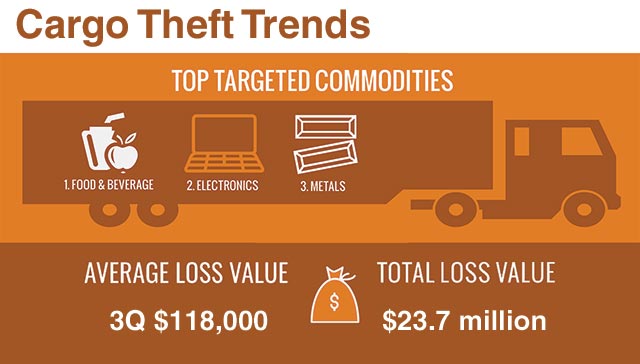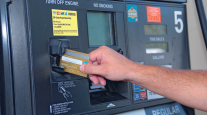Cargo Theft Off 9% in 3Q; Food, Drinks Top Target

This story appears in the Nov. 7 print edition of Transport Topics.
Cargo theft decreased in the third quarter nationwide compared with the same period a year ago, except for one part of California, but experts are pointing to some startling facts in what items are being stolen and how the thieves pull it off.
CargoNet, which operates a cargo theft database, reported 309 commercial vehicle thefts, 201 cargo thefts and 35 incidents of fraud between July 1 and Sept. 30.
The number of overall cargo thefts dropped 9% versus the same three-month period in 2015. In dollars, thieves stole $23.7 million worth of cargo — a 25% decline compared with a year ago, Cargo- Net reported Oct. 27.
The average cost of the cargo stolen in the quarter fell to $118,000 from $144,000 year-over-year, although CargoNet added that the figures were skewed because of two multimillion-dollar thefts in 2015.
Scott Cornell, Second Vice President and Crime and Theft Specialist for Travelers’ Transportation business, said the third-quarter results were consistent with the workload at his insurance unit. However, he said, the numbers aren’t always accurate because there isn’t mandatory reporting.
“You have to ask yourself whether cargo theft is down, or is the voluntary reporting down? You have to ask whether these companies have more or fewer clients in a given year,” Cornell said.
CargoNet said cargo thefts dropped 13% in Los Angeles County but rose 229% year-over-year in nearby San Bernardino County. Cornell said the numbers are volatile and based on law enforcement crackdowns or raids in a specific time period.
Southern California is the biggest hot spot for cargo thefts, accounting for about 40% of the nationwide total, according to industry watchers.
“Los Angeles is the biggest port in the country, so you’re going to have ample supply of cargo. You also have the most organized gangs in the country in Los Angeles. You’re also in close proximity to Mexico, and Mexican customs don’t do a good job of preventing anything from going over the borders,” said Anthony DiPasquale, U.S. marine cargo product leader at Aon Risk Services Inc., an insurance broker.
“Law enforcement agencies in Los Angeles County have a lot of expertise when it comes to cargo theft and have several cargo theft specific units, which is not the norm across the country,” said Anthony Canale, general manager at CargoNet.
Texas had the second-most cargo thefts, with 28 in the third quarter. Cornell said both states have large populations, a big economy and significant cross-border cargo business, which he calls the “perfect storm.”
Cargo thefts in 2016 are on pace to match last year’s total of about 750, and the figure could double to 1,500 with commercial vehicle thefts and fraud incident reports. According to CargoNet, the average value of the stolen cargo is about $100,000 to $150,000.
“Holiday weekends are a lucrative extended period of time for cargo thieves because they know some truck drivers want to handle loads quickly and get home,” said Chris McLoughlin, cargo risk manager for C.H. Robinson Worldwide, which ranks No. 4 on the Transport Topics Top 50 list of the largest logistics companies in North America.
Electronics were the costliest commodity stolen but dropped to $7.8 million in losses versus $14.5 million one year ago, CargoNet said. Household items were the second-costliest cargo thefts at $4.6 million, a 138% jump year-over-year. Food and beverage commodities remained the most frequently stolen commodity but decreased 22% year-over-year.
“Electronics are getting more traceable through the internet. That’s why food and beverages are so popular. You don’t activate frozen chicken over the internet. Pistachios don’t have serial numbers. I can trace a load of televisions for a year or two, but once you eat the pistachios, it’s done,” Cornell said.
“Food and beverage items are being sold to local restaurants, small grocers, in some cases being given to a food broker and sold in a large quantity back into the supply chain it was stolen from,” Canale added.
McLoughlin said that, most of the time, the cargo is already sold before it’s even stolen.
“The thieves know exactly who wants it, what they want and what they can get for it. The cargo thieves are very sophisticated and efficient from a logistics perspective,” he added.
Insurance providers offer products to cargo owners to cover these thefts. Basic transit coverage will protect importers or exporters against any damage or loss during the transport. Carriers also have motor truck cargo insurance to cover themselves.
Warehouses remained the most frequent locations for cargo theft. Theft at secured yards were the second-most common location, with a 100% year-over-year increase. Unsecured yards came in third and increased 134% year-over-year, according to CargoNet.
“Cargo thieves spy on these facilities, observing when the trucks enter and exit, when the guards make their rounds and whether there are motion sensors. They sometimes case a facility for months,” DiPasquale said. “Sometimes, thieves will cut the alarm, step back to see the response, and if there’s no backup, then they’ll re-enter the facility.”




